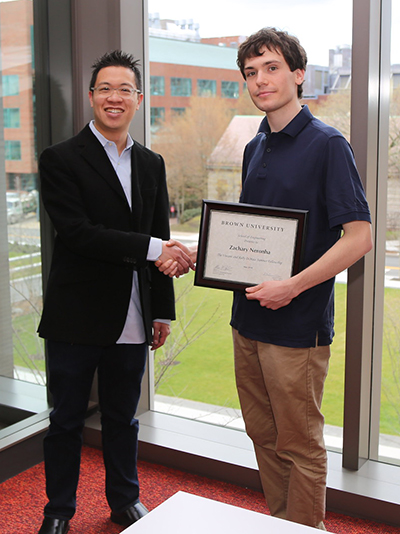Quantitative science adds insight to cell motility
A DiMase Family Summer Internship allows Zachary Neronha ’19 to examine the collective migration of individual and groups of cancerous cells.
When it comes to applying computational techniques and engineering principles to large, biological datasets, biomedical engineering’s Zachary Neronha ’19 enjoys the challenge. The Jamestown, R.I. native was happy to spend last summer behind a computer and counts it as another opportunity at Brown that helped develop his love for quantitative science.

It was his first-year adviser, former Brown Associate Professor Petia Vlahovska who nudged Neronha toward the Wong Lab as early as Neronha’s first semester. Although immersed in engineering physics intro classes, he was intrigued by the biomedical engineering professors who were applying the quantitative method to bioscience. Ian Wong, an assistant professor who had joined the Brown faculty three years prior, was developing a reputation for running an interdisciplinary lab, where there was room to explore applications grounded in the life sciences. Neronha followed Vlahovska’s advice, reached out, and was fascinated by the novel experiments Susan Leggett Ph.D. ’18 was performing to shed light on the invasion and drug resistance of cancer cells.
Leggett, who is currently a postdoctoral researcher in Wong’s lab, focused her Ph.D. project on gaining an enhanced quantitative understanding of metastasis by investigating the group migration of human mammary epithelial cells. This is of relevance to cancer because tumors are often heterogeneous and disseminate both individually and in groups.
Neronha’s interests in quantitative science was a perfect fit to mathematically characterize this phenomenon.
“Previous studies have shown an enhanced metastatic risk associated with clusters of circulating tumor cells in comparison with single cells. Our work indicates that certain culture factor conditions may promote the formation of stable multicellular clusters that are ‘jammed’.” This biological behavior gave need for new quantitative insights into the cell migration of tumor metastasis. “We worked rigorously to quantify this behavior and compare it to that of real and theoretical non-living systems.” Specifically, the cells formed branching aggregates reminiscent of non-living colloidal particles.
For his efforts, Neronha was rewarded with a 10-week DiMase Summer Internship. “I’m grateful to have the opportunity to pursue research over the summer, because it’s important to know if you like it, or if the skill set suits you. Research requires a different way of thinking than the classroom.
“Immediately in the lab, you have to have the frame of mind, ‘how can I contribute something new?’,” he said. “You learn by doing. You see the problem and have to figure out how to solve it. It’s troubleshooting, failing, and trying a new approach. But the skills you acquire there, quickly learning on the job, are so valuable.”
There’s an extraordinary potential for biomedical engineering to revolutionize healthcare in our lifetimes. I’d like to be a clinician or researcher to be at the forefront of integrating these technologies.
Since the start of the school year, he has shifted his focus to a senior thesis also involving quantitative insight into tumor microenvironments. He hopes to integrate concepts from applied topography to reveal signatures of cancer metastasis in 3D.
From there, he will consider all the opportunities his four years on College Hill have given him, among them co-president of the Biomedical Engineering Society, volunteer in the geriatric ward at Rhode Island hospital, organic chemistry tutor, Hack Health competition winner, and a pair of Undergraduate Teaching and Research Awards for collaborative research projects, while determining whether to pursue a Ph.D., M.D., or both.
“There’s an extraordinary potential for biomedical engineering to revolutionize healthcare in our lifetimes. I’d like to be a clinician or researcher to be at the forefront of integrating these technologies,” he said.